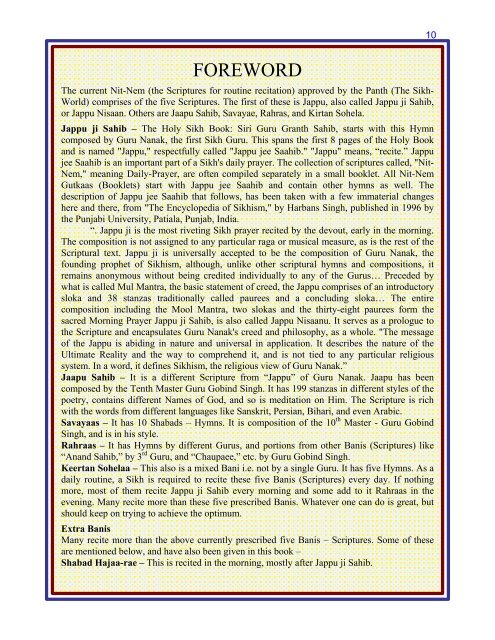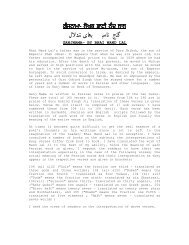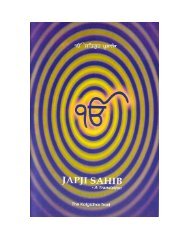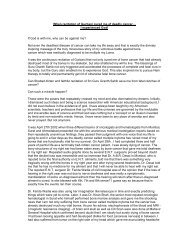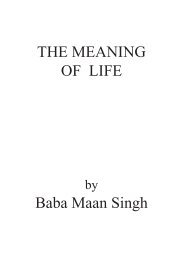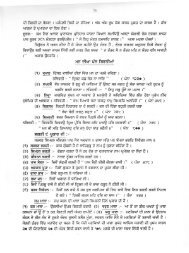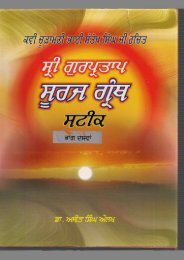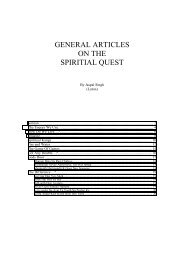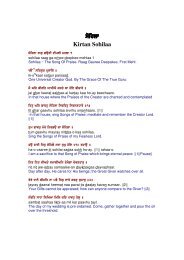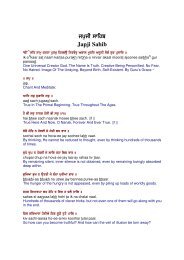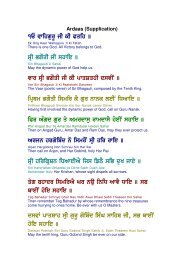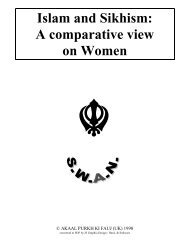Nitnem by Dr. Kulwant Singh, with Punjabi & English ... - Gurbani Files
Nitnem by Dr. Kulwant Singh, with Punjabi & English ... - Gurbani Files
Nitnem by Dr. Kulwant Singh, with Punjabi & English ... - Gurbani Files
- No tags were found...
Create successful ePaper yourself
Turn your PDF publications into a flip-book with our unique Google optimized e-Paper software.
FOREWORDThe current Nit-Nem (the Scriptures for routine recitation) approved <strong>by</strong> the Panth (The Sikh-World) comprises of the five Scriptures. The first of these is Jappu, also called Jappu ji Sahib,or Jappu Nisaan. Others are Jaapu Sahib, Savayae, Rahras, and Kirtan Sohela.Jappu ji Sahib – The Holy Sikh Book: Siri Guru Granth Sahib, starts <strong>with</strong> this Hymncomposed <strong>by</strong> Guru Nanak, the first Sikh Guru. This spans the first 8 pages of the Holy Bookand is named "Jappu," respectfully called "Jappu jee Saahib." "Jappu" means, “recite.” Jappujee Saahib is an important part of a Sikh's daily prayer. The collection of scriptures called, "Nit-Nem," meaning Daily-Prayer, are often compiled separately in a small booklet. All Nit-NemGutkaas (Booklets) start <strong>with</strong> Jappu jee Saahib and contain other hymns as well. Thedescription of Jappu jee Saahib that follows, has been taken <strong>with</strong> a few immaterial changeshere and there, from "The Encyclopedia of Sikhism," <strong>by</strong> Harbans <strong>Singh</strong>, published in 1996 <strong>by</strong>the <strong>Punjabi</strong> University, Patiala, Punjab, India.“. Jappu ji is the most riveting Sikh prayer recited <strong>by</strong> the devout, early in the morning.The composition is not assigned to any particular raga or musical measure, as is the rest of theScriptural text. Jappu ji is universally accepted to be the composition of Guru Nanak, thefounding prophet of Sikhism, although, unlike other scriptural hymns and compositions, itremains anonymous <strong>with</strong>out being credited individually to any of the Gurus… Preceded <strong>by</strong>what is called Mul Mantra, the basic statement of creed, the Jappu comprises of an introductorysloka and 38 stanzas traditionally called paurees and a concluding sloka… The entirecomposition including the Mool Mantra, two slokas and the thirty-eight paurees form thesacred Morning Prayer Jappu ji Sahib, is also called Jappu Nisaanu. It serves as a prologue tothe Scripture and encapsulates Guru Nanak's creed and philosophy, as a whole. "The messageof the Jappu is abiding in nature and universal in application. It describes the nature of theUltimate Reality and the way to comprehend it, and is not tied to any particular religioussystem. In a word, it defines Sikhism, the religious view of Guru Nanak.”Jaapu Sahib – It is a different Scripture from “Jappu” of Guru Nanak. Jaapu has beencomposed <strong>by</strong> the Tenth Master Guru Gobind <strong>Singh</strong>. It has 199 stanzas in different styles of thepoetry, contains different Names of God, and so is meditation on Him. The Scripture is rich<strong>with</strong> the words from different languages like Sanskrit, Persian, Bihari, and even Arabic.Savayaas – It has 10 Shabads – Hymns. It is composition of the 10 th Master - Guru Gobind<strong>Singh</strong>, and is in his style.Rahraas – It has Hymns <strong>by</strong> different Gurus, and portions from other Banis (Scriptures) like“Anand Sahib,” <strong>by</strong> 3 rd Guru, and “Chaupaee,” etc. <strong>by</strong> Guru Gobind <strong>Singh</strong>.Keertan Sohelaa – This also is a mixed Bani i.e. not <strong>by</strong> a single Guru. It has five Hymns. As adaily routine, a Sikh is required to recite these five Banis (Scriptures) every day. If nothingmore, most of them recite Jappu ji Sahib every morning and some add to it Rahraas in theevening. Many recite more than these five prescribed Banis. Whatever one can do is great, butshould keep on trying to achieve the optimum.Extra BanisMany recite more than the above currently prescribed five Banis – Scriptures. Some of theseare mentioned below, and have also been given in this book –Shabad Hajaa-rae – This is recited in the morning, mostly after Jappu ji Sahib.10


